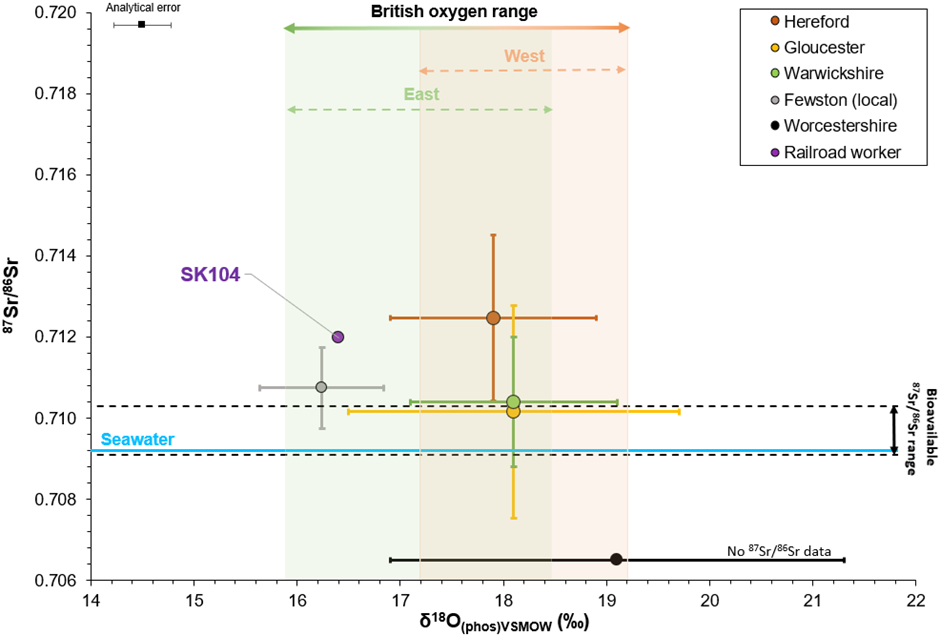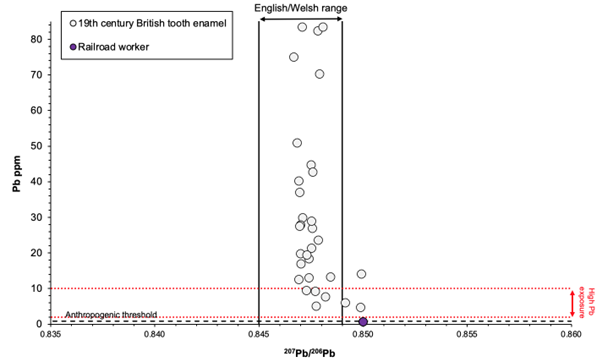Body on the Bromyard Line 3 – The Isotope Results
- 16th May 2024
This is the third in a series of five posts exploring the story behind the human skeleton found buried within an embankment of the Worcester, Bromyard and Leominster railway line in 2021, close to Riverlands Farm in Leigh, to the west of Worcester.
Over this mini-series we explore the discovery, and what we have learnt through the archaeological excavation, scientific analyses and documentary research. Built in the 1860s, the line eventually closed in the 1960s, and by 2021 all that remained was the earthwork of the former embankment that took a narrow lane up and over the railway. Hidden within the bank was a single human skeleton (see Blog 1: The Discovery).
The skeleton was sampled for isotope analysis in an attempt to understand more about this man’s life, and potentially from where he originated. Isotopes are two or more forms of the same element that contain different numbers of neutrons in their nuclei. This means that they differ in relative atomic mass, but not in chemical properties. They are present in everything that we ingest, but the ratios of different isotopes of the same element vary between different environments. Isotopes build up in our body tissues and bones from the food we eat, the air we breathe and the water we drink. By measuring the ratios of different isotopes in bones or teeth we can trace them back to the sources that they came from.
Archaeologists can establish the general diet and environment of individuals throughout their life. Bone is replaced throughout life, and it can offer data on long-term dietary trends in the decades prior to death. Teeth, on the other hand, are formed during childhood and late adolescence and do not remodel. By comparing samples from a tooth and a bone (e.g. a rib) it is possible to tell if an individual lived somewhere different, or had a very different diet, in adulthood to that of their childhood. In this way isotope analysis can tell us about the origins and migrations of both individuals and whole populations.
The Archaeological Isotope and Peptide Research Laboratory (AIPRL) in the Department of Archaeology at Durham University undertook the isotope analyses for us in the summer of 2023. A second molar was analysed for strontium, lead, and oxygen isotopes to reconstruct childhood geographic origins. Bulk bone (rib) and collagen (tooth) were analysed for sulphur, carbon and nitrogen isotopes to investigate dietary changes during childhood (period of tooth formation) and in later life (rib).
The results from the oxygen and strontium analyses, to explore childhood location, suggest that this individual did not grow up around Worcestershire. Oxygen isotopes measured in human tissues are an indirect reflection of the local water composition. Strontium isotopes can also provide a direct link between an individual and their geographic origin, as they are ultimately derived from the local geology. Assuming that most food and drink is sourced locally, the strontium and oxygen isotope proportions in human skeletons will reflect the underlying geology. Below is a graph showing the strontium results plotted against the oxygen results. Our body (named SK104) fits with the range typical across eastern Britain, and most closely aligns with the samples from Fewston in North Yorkshire.

A plot of the strontium ratios against the oxygen ratios. The purple dot is our body. He most closely aligns with the samples from Fewston, North Yorkshire (AIPRL, Durham University)
Together with an unusually low lead concentration, as demonstrated in the table below, the oxygen/strontium results point to possible childhood origins in a rural, or unpolluted region of Britain, underlain with Palaeozoic rocks. Regions with such combinations include eastern Scotland and north Yorkshire. However, if he had grown up in eastern Scotland, we would expect his lead concentration from the underlying geology to be higher. The lead concentration likely rules out Scotland. This leaves north Yorkshire as a strong possibility, if he came from the British Isles.

A plot of the lead concentration. The purple dot at the bottom is our body, the grey dots are all tooth enamel lead concentrations in 19th century individuals from Britain – as you can see most have much higher levels than our individual. (AIPRL, Durham University)
The carbon and nitrogen isotopes indicate that this individual ate a predominantly land-based diet throughout his life. He was eating a significant amount of animal protein (meat, cheese, milk etc) alongside foods like wheat, barley and root veg. This is unusual when compared to diets in 19th century urban sites where marine protein was commonly consumed. However, individuals from Fewston, a low status rural 19th century site associated with the cotton mills in north Yorkshire, had diets similarly bereft of marine protein. Not only does this further support a childhood in a rural, inland location, it might also suggest that his diet in both childhood and adulthood was limited in variety by a lack of wealth.
All conclusions must be drawn with caution, but the isotope analyses, combined with the osteological evidence and the location the body was found in, continue to support the hypothesis that this body was someone who died constructing the Worcester, Bromyard and Leominster railway line. Someone who was not local to Worcestershire, but an itinerant worker, who travelled where the railway contracts led him. In the next blog, we will look at the lives of these men, known as navvies. What might his life have been like in the months and years before his death? Find out in the next blog: Body on the Bromyard Line Blog 4
The information in this post is taken from:
Moore. J. Montgomery, J. 2024. Specialist Report: Multi-isotope study of a 19th century skeleton recovered in Leigh, Worcestershire. AIPRL Report No. 179. Department of Archaeology, Durham University. Unpublished report.
Post a Comment